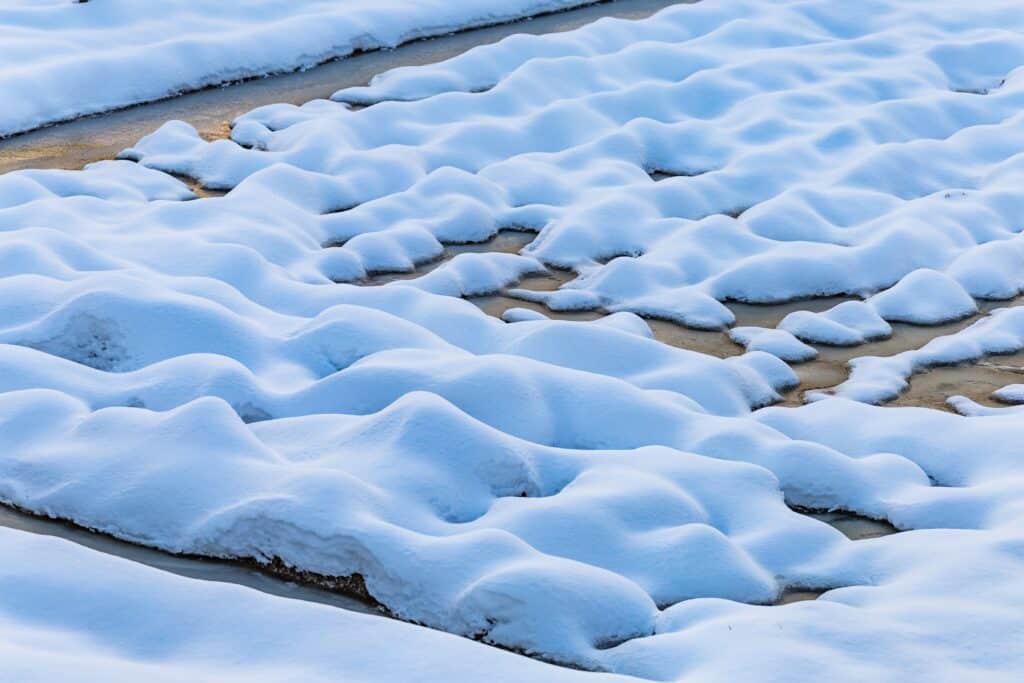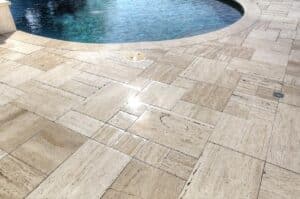As winter sets in, your outdoor spaces – including driveways, walkways, and patios – may face the wrath of harsh weather conditions. Among the most vulnerable components are your pavers, so learning how to care for pavers in the winter is a must to preserve their lifespan.
These wonderful additions to your landscape can suffer from the effects of freezing temperatures, snow, ice, and salt. But with proper care and maintenance, you can ensure that your pavers remain in excellent condition throughout winter.
Our goal with this article is to give you a comprehensive guide on such a task and ensure your pavers are protected during the winter months.
Read as well: Does hardscape increase home value?
How to care for pavers in the winter in 6 steps

1. Clean thoroughly before winter
Before winter arrives, it’s crucial to give your pavers a thorough cleaning. Remove any debris, leaves, and organic matter that have accumulated on the surface. Use a stiff broom or a leaf blower to clear the area effectively.
Additionally, consider pressure washing the pavers to remove any embedded dirt or stains. A clean surface will make it easier to monitor and maintain the pavers during the winter months.
2. Seal the pavers
Sealing your pavers before the onset of winter can provide an extra layer of protection against moisture penetration and freeze-thaw cycles.
Choose a high-quality sealer specifically designed for pavers and apply it according to the manufacturer’s instructions. Sealing the pavers will help prevent water damage and minimize the formation of cracks and efflorescence.
3. Fill in the joints
Inspect the joints between the pavers and make sure they are properly filled with polymeric sand. Polymeric sand helps to lock the pavers in place and prevent weed growth and erosion of the jointing material during winter.
If you notice any gaps or areas where the jointing material has deteriorated, refill them before winter arrives to maintain the structural integrity of the paved surface.
4. Protect from snow and ice
Snow and ice accumulation, as well as our measures to get rid of it, can pose a significant threat to your pavers.
Avoid using metal shovels or sharp tools to remove snow, as they can scratch or chip the surface of the pavers. Instead, opt for a plastic snow shovel or a snow blower with rubber paddles to clear snow without causing damage.
Additionally, refrain from using de-icing salts or chemicals that can corrode the pavers. Instead, use sand or environmentally friendly ice melt products sparingly to improve traction without compromising the integrity of the pavers.
5. Monitor and maintain
Throughout winter, make it a habit to regularly inspect your pavers for any signs of damage or deterioration. Look for cracks, chips, or uneven settling, and address any issues promptly to prevent them from worsening.
If you notice any areas where water is pooling or not draining properly, investigate the underlying cause and take corrective measures as needed. Staying vigilant and proactive prevents minor issues from escalating into costly repairs.
6. Plan for spring maintenance
As winter comes to an end, plan for a thorough inspection and maintenance of your pavers to undo any damage caused by the cold weather.
Remove any remaining debris or salt residue from the surface, and inspect the pavers for signs of damage or shifting. Consider resealing the pavers if necessary to prolong their lifespan and enhance their appearance.

Effects of winter on different types of pavers
Winter weather can have varying effects on different types of pavers, depending on their material composition, installation method, and maintenance.
Concrete pavers
Concrete pavers can crack due to freeze-thaw cycles. When water seeps into the porous surface of concrete and freezes, it expands, creating pressure that can lead to cracking.
Exposure to de-icing salts or chemicals used to melt snow and ice can also cause discoloration on concrete pavers over time.
Efflorescence, the white powdery substance that forms on the surface of concrete, can be exacerbated by moisture and freezing temperatures.
Brick pavers
Clay brick pavers are susceptible to frost heave, where water in the soil beneath the pavers freezes and expands, causing the pavers to rise unevenly.
Similar to concrete pavers, brick pavers can also experience efflorescence during winter months due to moisture and temperature fluctuations, and freeze-thaw cycles can cause the surface of brick pavers to flake or spall.
Natural stone pavers
Some types of natural stone, particularly those with high porosity, can crack when exposed to freezing temperatures and moisture.
They are also prone to staining from de-icing chemicals or organic materials like leaves and debris that get trapped in surface imperfections.
As for the freeze-thaw cycles, they can accelerate the weathering process of natural stone, leading to surface degradation over time.
Porcelain pavers
Although porcelain pavers are particularly resistant, during the winter they are susceptible to the same problems as the other materials.
Expansion and contraction due to freeze-thaw cycles, staining from snow, ice, and de-icing salts, and the formation of efflorescence are common problems.
Additionally, porcelain pavers can become slippery when wet, and during winter, snow and ice can exacerbate this issue. This can pose a safety hazard, especially on sloped surfaces or areas with heavy foot traffic.
To mitigate this, it’s important to choose porcelain pavers with textured surfaces or apply anti-slip coatings.
Read our complete guide on how to care for pavers in the summer here!

Get professional help to learn how to care for pavers in the winter
Overall, proper installation techniques, adequate base preparation, and regular maintenance are essential for minimizing the negative effects of winter weather on all types of pavers.
Selecting pavers specifically designed to withstand freezing temperatures and moisture can help prolong their lifespan in cold climates. As you just saw, caring for pavers during the winter months requires proactive maintenance and protective measures to withstand the challenges posed by snow, ice, and freezing temperatures.
To make sure you have all that covered, your best course of action is to hire professionals to help you.
We here at S&S Pavers, during our 14 years of experience, have helped countless homeowners with their paver maintenance during winter, so we know how important being thorough with every aspect is. So if you happen to be around our area of activity, the Sarasota and Manatee counties, in FL, you can contact us anytime for a free estimate on our services – we can provide the same important assistance for you.




